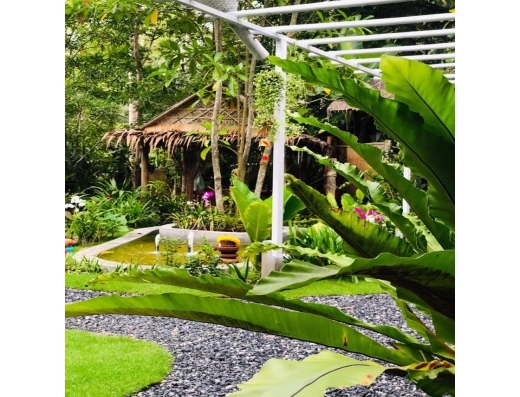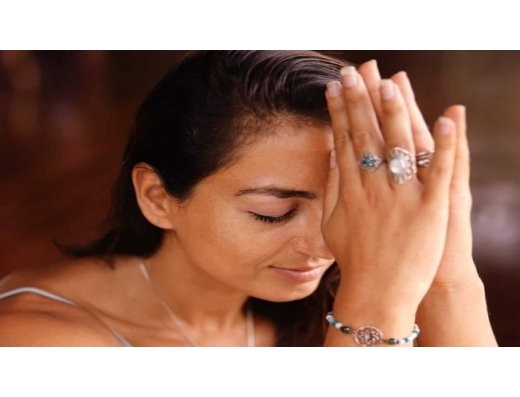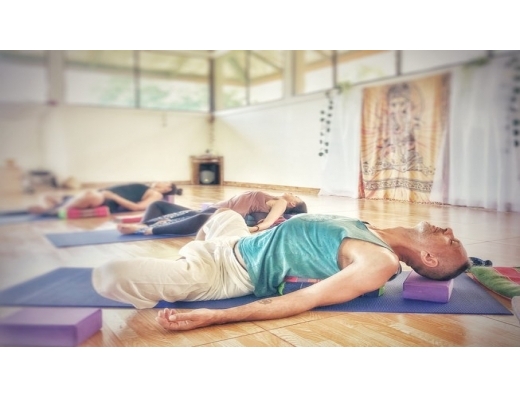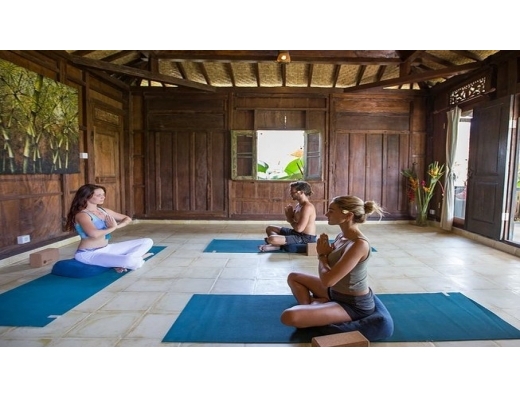Yoga Teacher Training in Indonesia
In this 200-hour teacher training program, we offer you an immersive and thoroughly comprehensive yoga experience. You’ll be able to indulge in the comforts of a five-star service while enjoying 20 nights in a tropical paradise that combines luxury with eco-conscious design. Our goal in designing this course is to help you improve your skills based on your preferred yoga style. With a focus on Hatha and Vinyasa yoga, pranayama, meditation, philosophy, anatomy, yoga therapy, alignment, and yoga psychology, we provide a solid foundation of knowledge and practice.
Program
200-Hour yoga teacher training
During this 200-hour multi-style yoga teacher training, there will be daily kirtan, or mantra chanting, which is one of the most fundamental yoga practices. Although the exercise is straightforward, the internal process it sparks is vast and mysterious. These lessons will be accompanied by a musician twice a week.This course is specially designed to provide students with a full understanding of yogic concepts, practices, and philosophy, but mostly Hatha, Vinyasa, and Ashtanga, with some Yin, Nidra, and Kriya knowledge. You will be engaged in the ancient practice of yoga, exploring this knowledge in depth with enthusiastic instructors in a nourishing atmosphere for your heart and soul, with other spiritual searchers.A team of experienced educators will help you improve your mindfulness. The retreat focuses on both Hatha and Ashtanga Vinyasa yoga, so you may practice true multi-style yoga, and learn more about yoga philosophy, anatomy, and physiology.Enjoy some interesting adventures while experiencing life on the beautiful island of Bali.
Eligibility
- If you are new to yoga, then there will be no specific background of yoga required, and just being eager to learn is enough.
- If you have been practicing yoga for a long time, but don’t have knowledge of anatomy, foundation of the asanas and yoga philosophy.
- If you don't want to be a yoga teacher but desire to deepen your own yoga practice and knowledge.
What you will achieve from this 200-hour teacher training:
- Solid basic foundation to deepen your asana practice
- Better understanding of the asanas with a solid understanding of anatomy, adjustment, and alignment
- Learning pranayama, yoga philosophy, meditation, and more
- Understanding of the traditional and authentic yogic texts to get to know more about yogic aphorisms
- Experience spirituality in Bali, Indonesia
- Get a 200-hour yoga teacher training certificate to realize your inner consciousness and develop your practice
Benefits of attending this yoga teacher training course:
- You become more controlled
- You will have more understanding in your life
- You become more emotionally balanced
- You develop a stronger personal practice
- You will be connected with the ancient yoga tradition of India and receive guidance whenever you need it
- Your family and friends can also join the ashram
Amenities on arrival
Students will receive welcome drinks upon arrival, and fruits will be at the reception desk where students can take them freely.If students arrive during breakfast, lunch, or dinner, then they are welcome to eat in the dining hall.For students coming from other hotels, it is possible for a car or scooter to pick you up and help with anything you need. Let Bali Yoga Retreat know.
Preparations
The 200-hour yoga teacher training course is taught systematically from the basics so students do not need to prepare so much but it is encouraged for the students to read a few books which will help them to understand the teachings easily.
Suggested books:
- Living with Himalayan Masters
- The Royal Path
- Asana Pranayama Mudra Bandha
Overview
1. Hatha yoga
Hatha yoga is the traditional method of practicing yoga postures which include aligning the body posture, getting rid of toxins, losing weight, overall health, taking away fatigue, and relaxing the mind. It leads to stillness and prepares one to meditate.
Surya Namaskar (sun salutation) and asana alignment, assist and adjustment for the following asanas:
- Pawanmuktasana series 1
- Pawanmuktasana series 2
- Pawanmuktasana series 3
- Surya Namaskar (sun salutation)
- Chandra Namaskar (moon salutation)
- Tadasana (palm tree pose)
- Triyak tadasana (swaying palm tree pose)
- Trikonasana (triangle pose)
- Parivirtatrikon asana (revolving triangle pose)
- Uttkatasana (chair pose)
- Virbhdrasana 1 – warrior 1
- Virbhdrasana 2 – warrior 2
- Virbhdrasana 2 – warrior 3
- Ardha Chandrasana (half-moon pose)
- Vriksasana (tree pose)
2. Vinyasa yoga
Vinyasa is a synchronized movement of body, breath and mind where the students can get warm and flexible through this practice. It is a kind of moving meditation that brings health and harmony.
Coverage: alignment, Drishti, adjustment, and options
- Surya Namaskar A
- Surya Namaskar B
Asanas for beginners
- Padangusthasana
- Padahasthasana
- Utthita Trikonasana
- Parivrtta Trikonasana
- Utthita Parsvakonasana
- Parivrtta Parsvakonasana
- Prasarita Padottanasana A, B, C and D
- Parsvottanasana
- Eka Pada Padangusthasana A, B, C and D
- Ardha Baddha Padmottanasana
- Utkatasana
- Virabhadrasana A and B
- Dandasana
- Paschimottanasana A, B, C and D
- Purvattanasana
- Ardha Baddha Padma Uttanasana
- Triang Mukaikapada Pashimottanasana
- Janu Sirsasana A, B and C
- Marichyasana A, B and C
- Navasana
3. Pranayama (breathing practices)
Pranayama contains various breathing exercises but the goal is not the breath but rather to reach the level of prana force which is the source of all existence. Through breathing practices, one can achieve a deep physical, energetic and emotional cleaning.Pranayama is an ancient yogic breathing technique that is used as preparation for meditation and is a vital aspect of practicing yoga. It improves the respiratory system and purifies the body and mind.
Introduction of pranayama
Implementing breathwork in yoga poses allows for more opening and presence. Come experience the interplay of breath, movement and energy and leave with an overall sense of wellbeing.
Benefits of pranayama
Daily pranayama trains the lungs and improves the capacity of the respiratory system immensely. Pranayama works directly on the nervous system. Daily pranayama positively affects autonomic nervous system which controls and governs essential functions of the body like the heart rate, respiration and blood pressure etc.
Clavicular, Thoracic and Diaphragmatic Breathing (yogic breathing)
Clavicular breathing is breathing into the top third of the lungs and no deeper. Clavicular breathing is accomplished by raising the collarbone (clavicle) and shoulders during the inbreath and keeping the rest of the torso motionless. Clavicular breathing is the shallowest type of breathing.
Ujjayi
Ujjayi breathing is a breathing technique employed in a variety of Taoist and yoga practices. In relation to yoga, it is sometimes called "the ocean breath".
Bhastrika
Bhastrikā is an important breath exercise in yoga and pranayama. It is sometimes treated as a kriya or cleansing action along with kapalabhati to clear the airways in preparation for other pranayama techniques. Bhastrika involves a rapid and forceful process of inhalation and exhalation powered by the movement of the diaphragm. The movement of the air is accompanied by an audible sound. One inhale and exhale equal one round of bhastrika, and it may be repeated for many consecutive rounds.
Kapalbhati
Kapalabhati also called breath of fire is an important shatkarma, which is purification in Hatha yoga. The technique of Kapalabhati involves short and strong forceful exhalations and inhalation happens automatically.
There are three forms of Kapalabhati:
- Vatakrama kapalabhati – A practice similar to the pranayama technique of Bhastrika, except that exhalation is active while inhalation is passive, the opposite of normal breathing.
- Vyutkrama kapalabhati – It is a practice similar to Jala neti, which involves sniffing water through the nostrils and letting it flow down into the mouth, and then spitting it out.
- Sheetkrama kapalabhati – It can can be considered the reverse of Vyutkrama kapalabhati, in which water is taken through the mouth and expelled through the nose.
Nadi (Sodhana)
Nadi is a Sanskrit word meaning “channel” or “flow” and shodhana means “purification.” Therefore, Nadi shodhana is primarily aimed at clearing and purifying the subtle channels of the mind-body organism, while balancing its masculine and feminine aspects.
Bhramari
Bhramari pranayama, also known as "humming bee breath" is a calming breathing practice that soothes the nervous system and helps you connect with your truest inner nature.
Surya – Bhedi and Chandra – Bhedi
In Chandra Bhedana Pranayama, the left nostril is used for inhalation and right nostril is used for exhalation. It is said that on inhalation, energy passes through Ida (Chandra) Nadi and on exhalation through Pingala or Surya Nadi.
Sheetali and Sheetkari
Sheetali pranayama, also known as cooling breath, is a breathing practice that very effectively cools the body, the mind, and the emotions. Sheetali comes from the Sanskrit root sheet, which means “cold” or “frigid.” Sheetal translates roughly as "that which is calm, passionless, and soothing".Sheetali pranayama calms and soothes the mind-body organism by activating a powerful evaporative cooling mechanism on the inhalation, delivering a gently cooling energy to the deep tissues of the body. Remarkably, this pranayama also enkindles the digestive fire, like just as a live coal covered in ash might begin to glow under the influence of a cold wind.
Sitting postures for pranayama sadhana:
- Easy pose
- Half-lotus
- Swastikasana
4. Anatomy and physiology (Sharir Vijnan)
- Digestive system
- Respiratory system
- Nervous system
- Organs
- Bodily systems
- Nadis
- Chakras
5. Yoga therapy and cleansing techniques (Shatkarma)
Yoga therapy
Yoga is a therapy and students will learn how to treat different physical, mental and emotional problems through yoga.
Cleansing techniques (Shatkarma)
This technique can help get rid of toxins and embrace a pleasant and refreshing life.
6. Mantra chanting
Mantras are powerful sound vibrations which have healing and spiritual power. Regular chanting can be healthy and peaceful.
7. Study of asana
Study of asana: proper alignment, variations, modifications with ability to minimize the risk of injuries and hands-on adjustments
- Asanas are one of the most important facets of yoga. Each asana is performed for a particular beneficial reason. The reasons can vary and may include aligning the body posture, getting rid of toxins, losing weight, overall health, taking away fatigue, and relaxing the mind.
8. Art of sequencing and improvisation in the class
One of the key elements of this teacher training in Bali curriculum is to make future yoga teachers aware of the importance of sequencing. Sequencing has a vital role to play in conducting a successful and efficient class. A yoga class environment cannot be predicted at all times. It is in the hands of the teacher to engage the class, create a flow and share his/her teachings most suitably and effectively as possible.
9. Intelligent use of props
Intelligent use of props to help improve practice at its early stages. The course also consists of a part that teaches to enhance the effectiveness of a class with the use of props. Smart and intelligent use of props is a skill and is to be used to engage the class better.
10. Postures with their Sanskrit names and terminology
Postures along with their names and meanings are taught in detail. The meaning of a posture helps the learner understand it better and it will also have a better impact as compared to doing it for the sake of it.
11. Technique and practice of breathing (pranayama)
The practice of breathing is considered the foundation of yoga. Deep breathing combined with yoga has several benefits such as improved blood flow, detoxifying the body, and improving digestion among others.
12. Meditation (Dhyana)
A deeper level of meditation and concentration to know the truth is referred to as Dhyana. Dhyana is mostly done to reach Samadhi, meaning bliss which is the ultimate goal of yoga. Meditation is a systematic practice that promotes physical, mental and emotional tranquility with the purpose of reaching Samadhi (self-realization).
Breathing awareness meditation
Breath awareness meditation promotes physical and mental relaxation that can significantly reduce stress on the body and mind. The most basic way to do mindful breathing is simply to focus your attention on your breath, the inhale and exhale. You can do this while standing, but ideally, you’ll be sitting or even lying in a comfortable position. Your eyes may be open or closed, but you may find it easier to maintain your focus if you close your eyes. Experts believe a regular practice of mindful breathing can make it easier to do it in difficult situations.
Trataka
Trataka is a yogic purification and a tantric method of meditation that involves staring at a single point such as a small object, black dot or candle flame. It is said to bring energy to the "third eye" and promote various psychic abilities.
Dynamic meditation
Dynamic meditation is a fast, intense, physical and spiritual movement that helps you to release the past and clear the old patterns. It brings you peace, stillness, and freedom.
Tips for developing concentration
Through practice, it's normal that your mind sometimes wanders, the thoughts will come but that's alright. But when that happens, just bring your mind back to the present and bring awareness to your breath.
Silent meditation
Silent meditation is one of the most powerful meditation techniques. It helps you to connect and understand your true self.
13. Human anatomy and physiology
- Fundamentals of human anatomy and physiology
- Understanding human anatomy will help people understand yoga and its aspects better. This will also help achieve holistic health and the therapeutics of yoga practices.
14. Yoga philosophy, ideas, and hypothesis
Yoga is an ancient philosophy. In order to be a yoga teacher, one should understand the philosophy and ideas attached to it. Apart from this, they should also be able to share these same ideologies with their students in the future. This 200-hour yoga teacher training in Bali assures you that you will be able to share this philosophy with their worldwide crowd.
15. Confidence-building through teaching-practice
Teaching a skill by itself requires confidence. This teacher training ensures that enthusiasts are open to learning the skill of teaching and can excel the same in practice.
16. Yoga Nidra (psychic sleep)
When a yoga practitioner moves through the various internal states of yoga Nidra, a profound experience of relaxation occurs. This is called "Turiya" which is a sensation of pure bliss.
- Basic relaxation
- Tension relaxation
- Full body relaxation
17. Yoga cleansing (Shatkarma)
Yogic cleansing exercises are important to learn how to incorporate your breath and meditate properly during the physical aspects of yoga. It also removes the blockages in the energy channels.
- Rubber-neti
- Jalaneti
- Kapalbhati
18. Yoga philosophy
- Introduction to yoga, its philosophy, and evolution
- Introduction to yoga Sutras of Patanjali
- The definition of yoga
- 4 aspects of mind and its functions
- Daily schedule of a yoga student
- Principles of 5 basic elements and 10 senses
Week 2
- Yama and Niyama
- Asana, pranayama and pratyahara, dharana, dhyan, samadhi
Evaluation
- Assessments will be based on written as well as practical evaluation.
- Student conduct will be a part of the assessment criterion.
- Evaluation will be carried out only for those students who have a minimum of 90% attendance.
Code of conduct
- Discipline is an integral part of the training program and so the course routine must be strictly observed.
- Disrespect for rules and regulations could result in termination of studentship with no refund of fee.
- Absenting oneself from the scheduled program without prior permission of the teacher or manager concerned would be construed as a gross breach of discipline.
- Students must intimate in advance if they intend to forgo a meal so that there is no wastage of food.
- Bali Yoga Retreat does not make arrangements for guests or students. Any activity that is not related to the course is not permitted.
- Ensure you are on time for class or you will not be permitted to enter any class once it has commenced.
- Before departure from the Bali Yoga Retreat, students must pay all dues and return all library books.
- Smoking and alcohol are not permitted during the training.
Daily schedule
In line with keeping the requirements, the program follows a tight schedule where almost each of the 6 to 7 training hours in the day is assigned to some aspect of yoga. You could find the training intensive but enlightening.During training, you are provided with two to three yoga meals, fruit refreshments, and green tea.Daily written homework is also the norm, as it will be how you gain in-depth knowledge of the subject. Sleeping early is also encouraged, as part of the yogic practice.
- 06:15 – 06:30 Shatkarma
- 06:30 – 07:00 Pranayama
- 07:00 – 08:30 Vinyasa flow yoga
- 08:30 – 09:30 Breakfast
- 09:30 – 10:30 Yogic anatomy and physiology
- 10:30 – 11:30 Yoga philosophy
- 11:30 – 12:30 Body alignment
- 12:30 – 13:30 Lunch
- 16:00 – 17:30 Ashtanga primary series
- 18:00 – 19:00 Meditation
- 19:00 – 20:00 Dinner
Free day
On Sundays, you will only receive breakfast, and you can enjoy your lunch and dinner outside in the many beautiful cafes and restaurants.
Included excursions
Hey, on Sunday you have a free day with some awesome excursions planned as part of the full program. And guess what? Your course fees already cover all of these!
Retreat location
We’re having the retreat in Bali, Indonesia. Bali is known as the spiritual center and a gorgeous city, making it the perfect spot for learning and practicing yoga. The place has a rich cultural heritage and a peaceful atmosphere that helps create the perfect environment for self-discovery and inner exploration. Plus, the stunning beaches, breathtaking landscapes, lively vibe, and lush green surroundings provide a super soothing backdrop for our yoga sessions.
Food
Vegetarian meals
During your course, we will provide you with nutritious vegetarian food. You’ll get breakfast, lunch, and dinner every day, except for Sundays when you’re free to eat out.
The food
Bali and India are famous for their delicious cuisine. Ayurveda teaches us how to balance our bodies through diet. Different foods affect different systems and elements in our bodies. You’ll be treated to the most tasty and healthy meals during this course. Our kitchen team follows the spiritual guidelines of the ashram when preparing food. They do not use meat, eggs, or alcohol in their recipes, and they also encourage students to avoid them during the program.
Other dietary requirements
While vegetarian dishes will be the main focus throughout the program, we can accommodate other dietary requirements such as vegan, gluten-free, lactose-free, and fruit-based dishes, as well as Ayurvedic khichdi and salads.
The following meals are included:
- Breakfast
- Lunch
- Dinner
- Drinks
Spa treatments
The package includes an Ayurveda massage.
What's included
Here’s what’s included in our program:
– You’ll have all your classes.
– You’ll receive study material, such as a notebook and pen.
– You can choose to either have an e-manual or print your own manual.
– We’ll take you on a study tour.
– There will be a satsang with yogi Vishnu.
– You’ll get an Ayurveda massage.
– We’ll have kirtan sessions.
– You’ll enjoy 3 local sightseeing and excursions.
– There will be classical dance performances.
– You’ll receive a lifetime membership.
– You’ll also get a discount for any future courses you may take.
– You won’t have to worry about meals, as we’ll provide daily Asian vegetarian meals for breakfast, lunch, and dinner (excluding lunch and dinner on Sundays).
– You’ll have accommodation for 20 nights.
– Lastly, there will be an 18% GST added to the total amount.
What's not included
You have personal expenses, flight costs, travel insurance, additional tours, and extra spa treatments.
Features
Pricing
Get certified in Hatha, Ashtanga, and Vinyasa Yoga with a 21-day, 200-hour training program in Bali.
- $ 2,600.00
- $ 2,100.00
- $ 3,400.00
- $ 1,700.00






Leave a Reply